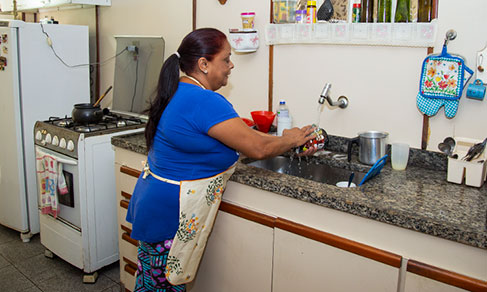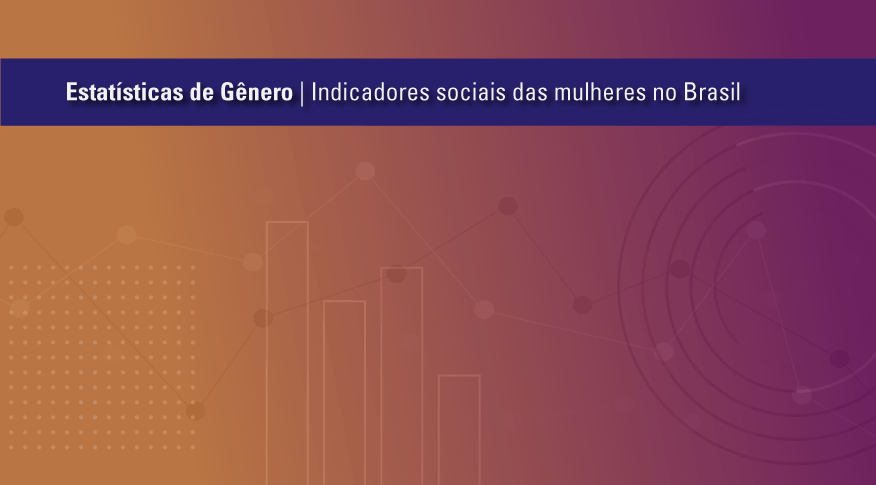Nossos serviços estão apresentando instabilidade no momento. Algumas informações podem não estar disponíveis.
Gender Statistics - Social indicators of women in Brazil
About - Social indicators of women in Brazil - 3rd Edition
In 2013, the United Nations Statistical Commission organized the Minimum Set of Gender Indicators (MSGI), comprising quantitative and qualitative indicators that reflect the effort of systematization of the information destined to the national production and international harmonization of statistics of countries and regions, related to gender equality and empowerment of women and girls.
With the release of the third edition of this report, the IBGE makes public the results of most quantitative indicators produced for this theme in Brazil, thus contributing to the production of systematized gender statistics for Brazil. The information is organized according to five domains - Economic empowerment, Education, Health and related services, Public life and decision taking, and Human rights of women and girls - and provide an overview of gender inequalities in Brazil, with valuable elements for the reflection of scholars and formulators of public policies. To do this, of the existing 51 quantitative indicators, 34 were built, complemented by other ten correlated to each theme, some of them as proxies of the original indicators, though without available data in Brazil.
To build the national indicators, data from the IBGE were used, like the Continuous National Household Sample Survey (Continuous PNAD), Population Projections by Sex and Age, Vital Statistics, National Survey of Health (PNS), Survey of Basic State Information (Estadic) and Survey of Basic Municipal Information (Munic), as well as data from external sources like the Ministry of Health, Presidency of the Republic, National Congress, Superior Electoral Court (TSE), National Council of Justice (CNJ) and National Institute of Educational Studies and Research Anísio Teixeira (INEP).
This study includes additional perspectives to the indicators proposed by the MSGI. The data were disaggregated by sex and, whenever possible, by Federation Unit and other characteristics, in order to reveal iniquities. It should be highlighted that, in the Brazilian case, “other characteristics” assume a relevant role, as shown in the time series of social indicators that point out that color or race, whether it is a disabled person or not and whether living in urban or rural area, among other constraints, can have a significant impact in people´s lives, reinforcing inequalities.
In addition to the report, the IBGE portal also shows the complete table plan, as well as the technical notes of the study, which present, for each theme, the conception of the indicators (produced according to metadata provided by the United Nations, proxies or complementary ones), the statistical sources used and the respective calculation methodology. In the table plan available, the tables follow the numbering of the MSGI indicators and are organized in thematic folders. The tables with complementary indicators, with a different numbering, are also allocated according to the theme.
Tables - Social indicators of women in Brazil - 3rd Edition
Complete Tables
Economic Empowerment (in xls and ods format)
Education (in xls and ods format)
Health and related services (in xls and ods format)
Public life and decision taking (in xls and ods format)
Human rights of women and girls (in xls and ods format)
Summary Table of Indicators (in xls and ods format)
Summary of Tables (in pdf format)
Concepts and methods - Social indicators of women in Brazil - 3rd Edition
As informações a seguir descrevem os metadados estatísticos, que são o conjunto de conceitos, métodos e aspectos relacionados às estatísticas, e são informações necessárias para compreender as características e a qualidade das estatísticas e interpretá-las corretamente.
Informações Gerais
Objetivo
O estudo visa contribuir para o preenchimento de lacunas na produção de estatísticas de gênero, apresentando resultados, para o Brasil, de grande parte dos indicadores que compõem o Conjunto Mínimo de Indicadores de Gênero - CMIG (Minimum Set of Gender Indicators - MSGI), organizado pela Comissão de Estatística das Nações Unidas (United Nations Statistical Commission). Inclui indicadores complementares relevantes para o Brasil e explora os ODS.Tipo de operação estatística
Sistema de indicadores sínteseTipo de dados
Dados de Censo, Registros administrativos, Dados de pesquisa por amostragem probabilística, Indicadores, Projeções e estimativas populacionaisPeriodicidade de divulgação
EventualMetodologia
Técnica de coleta:
Não se aplicaTemas
Temas e subtemas
Trabalho, Rendimento, despesa e consumo, População, Administração pública e participação político-social, Educação, Habitação, Saúde, Proteção social, Justiça e segurança, Uso do TempoPrincipais variáveis
Nível de ocupação de pessoas com ou sem crianças por sexoRazão e rendimento por grupos ocupacionais selecionados por sexo
Média de horas dedicadas aos cuidados de pessoas e/ou afazeres domésticos por pessoas ocupadas(horas semanais) por sexo
Rendimento habitual médio mensal de todos os trabalhos por sexo
Proporção de mulheres em cargos gerenciais
Taxa de fecundidade adolescente
Gravidez na adolescência
Nível de instrução de mulheres 25 anos ou mais
Prevalência contraceptiva
Razão de mortalidade materna
Taxa de homicídios dolosos contra mulheres
Palavras-chave
mulheres, gênero, desigualdade, indicadores sociais, educação, trabalho, renda, distribuição de renda, saúde, vida pública, direitos humanosUnidades de informação
Unidade de investigação
Pessoa, Município, Domicílio, Unidade da FederaçãoUnidade de análise
Unidade da Federação, Domicílio, Pessoa, MunicípioUnidade informante
Pessoa, Unidade da Federação, Domicílio, Empresa, Município.Períodos de referência
Disseminação
Formas de disseminação
Publicação impressa, Publicação Digital (online)Nível de desagregação geográfica
MunicípioSaiba mais
https://metadados.ibge.gov.br/consulta/estatisticos/operacoes-estatisticas/C9Publications - Social indicators of women in Brazil - 3rd Edition
Description
In 2013, the United Nations Statistical Commission organized the Minimum Set of Gender Indicators - MSGI, comprising 63 indicators (52 quantitative and 11 qualitative ones) which reflect the effort to systematize information destined to national production and international harmonization of country and regional statistics about gender equality and women empowerment.
With the release of the current report, the IBGE brings for the first time to the public the results of a great part of those indicators for Brazil, contributing, thus, to the filling of an important gap in he production of gender statistics. The information is divided into the five domains established by the MSGI – Economic structures and access to resources, Education, Health and related services, Public life and decision-making, and Human rights of women and child – and they offer an overview, however concise, of gender inequality in the country, with valuable elements for reflection of those who study and design public policies. To build the 38 indicators hereby disclosed, data from the IBGE were used, for instance, from the Continuous National Household Sample Survey - Continuous PNAD, the National Household Sample Survey - PNAD, Population Projections by Sex and Age, Vital Statistics, National Survey of Health - PNS and Survey of Basic State Information - Estadic, as well as data from external sources from the Ministry of Health, the Presidency of the Republic, the National Congress, the Superior Electoral Court - TSE and the National Institute for Educational Studies and Research Anísio Teixeira - INEP. All indicators, it should be noted, are in line with the methodology recommended by the United Nations.
The present study complements the publication Gender statistics: an analysis of the 2010 Population Census, launched by the IBGE in 2014, in the scope of the National System of Gender Information - SNIG.
This report is also available on the IBGE Internet portal, which also includes the complete table plan with several disaggregation levels, a summary table with the 38 indicators for Brazil, as well as the technical notes on the study, containing, for each theme, a definition of the indicators according to the metadata defined by the United Nations, the statistical sources used and the respective calculation methodology.
This fact sheet is also available in print. The technical notes on the study are disclosed separately and can be only accessed digitally on this page. They present the objective of the study and, for each topic addressed, the definition of the indicators according to the metadata established by the United Nations, the statistical sources used and the respective calculation methodology. The IBGE also makes the complete table plan available, with several disaggregations and a summary table with the 38 indicators for the level Brazil.
Downloads
Technical Information
Gender Statistics - Social indicators of women in Brazil
The technical notes can be found in the publication below:
https://biblioteca.ibge.gov.br/index.php/biblioteca-catalogo?view=detalhes&id=2101551
News and Releases
Black and brown women spend more time in household tasks, participate less in the labor market and are more affected by poverty
In Brazil, black and brown women are more affected by inequalities in education, labor market, income...
08/03/2024
Gender Statistics: women’s employment is lower in households with children up to three years of age
In 2019, employment-population ratio among women aged 25 to 49 living in households with children up...
04/03/2021
Errata
Change in the indicators of gender parity of school attendendance rates and of female participation in management positions
Published date: 18/05/2018
Description: The error in the indicators of gender parity resulted from a problem in the syntax that generates the tables of indicators. The error in the indicator of management positions resulted from a failure in the process of compatibilization between the codes of occupations from the International Standard Classification of Occupations 2008 (ISCO-08) and the Classification of Household Occupations (COD).
Actions: Correction of the tables released; correction of the summary table; correction of the fact sheet; correction of the technical notes.





